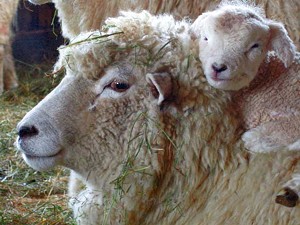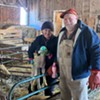Published March 11, 2009 at 8:08 a.m.
Which of the following is not true of sheep? Lambs are adorable. Lamb’s wool is warm. Lamb chops are to die for. A flock grazing under maples on an October day is a pastoral fantasy come to life. Sheep farming is where the big bucks are.
Old Vermonters sometimes refer to rams as “bucks.” Those are the only big bucks I’ve seen in sheep farming.
There are two ways to make a profit raising sheep: Work a second job or write a book about raising sheep. Since my other job — as an independent filmmaker — is financially sketchy, I think it’s time to write the book.
I don’t think I could improve on the dozen or so sheep-raising how-to guides currently in print. But that’s all right; I’ve got a new angle. In homage to Kiwi Godfrey Bowen’s seminal 1955 book Wool Away! The Art and Technique of Shearing, I’m toying with the title Run Away! The Art and Technique of Steering Clear of Sheep. Another possibility is to use a big number in the title. Is 666 Reasons for Saying No to Sheep enticing, or a turn-off? Ultimately, I will probably go with something that could grow into a franchise the way the Chicken Soup series has. I’m leaning toward Don’ Even Think About Sheep, which, like the “Dummies” books, might just take off. Imagine the possibilities: Don’ Even Think About Pugs. Don’ Even Think About Reiki. Don’ Even Think About Kazakh Cuisine.
One man might just foil my plans. His mother calls him Chester, but anybody with sheep in Vermont knows him as Chet. “I’m pretty much the sheep guy,” admits Chet Parsons with equal parts pride and responsibility. Parsons is a “livestock specialist” for the UVM Extension Office. He grew up in Richford, still lives there, and speaks with a touch of a Vermont accent. He got out of dairy farming and into sheep 20 years ago and currently maintains a flock of about 70 ewes. This spring, he’s offering a series of workshops called “Introduction to Sheep Management.”
Here’s the thing: My book won’t sell if someone as knowledgeable and reasonable as Chet is running around the state campaigning for sheep. I ask him what, as the sheep guy, his mission is. “If I can help sheep farmers become more profitable ... or lose less ...” he trails off before laughing softly and confessing, “Kind of a negative, I guess.”
If his quote doesn’t quite work as a blurb on the back of my book, it does recall an old joke: How do you make a million dollars raising sheep? Answer: Start with two million and keep farming until you have a million left.
Why is it so hard to make money with sheep? Let’s start with wool. In the Civil War, wool sold for more than $1 a pound. On the UVM Extension’s website, Parsons has created a “Sheep Enterprise Budget” to help neophytes get started. He estimates that a sheep produces 7 pounds of wool per year, with each pound going for 8 cents. That’s 56 cents of income. Most sheep shearers charge more than $7 per sheep now.
You say, “I just lost $6.44 on one sheep!” Alan Greenspan smiles inscrutably and whispers, “Then raise more sheep, dummy.” You wouldn’t know it from sweater shopping at Banana Republic, but there’s a glut of wool on the worldwide market, thanks to Australians and New Zealanders being very good at sheep farming.
There is money to be made in meat. Sheep farmers who supply niche restaurants, localvores or ethnic customers can get as much as $200 for a slaughtered lamb.
But consider the Vermont sheep farmer’s problems, starting with climate: For six months of the year, grass does not grow in Vermont. Most sheep farmers don’t make their own hay; none that I know of grows crops for grain. Let’s face it, unless you run a used bookstore and feed Jane Austen to your pigs, Vermont is a very expensive place to raise livestock.
Another challenge is the U.S. diet. Americans consume 64 pounds of beef a year; they eat less than 1 pound of lamb every 12 months. Call me when the “McShank” is introduced.
Economies of scale? The fact is, if five sheep farms with 500 ewes each appeared in Vermont tomorrow, the local meat market would crash. The lamb market is not unlike the duck market or the chanterelle market; it kind of works at the moment because it’s so small potatoes.
I only milk my sheep when they have mastitis or I need colostrum for an orphan, so I plead ignorant when it comes to the profitability of sheep dairies. Yes, Vermont is fast becoming the artisanal cheese capital of America. The only thing I know for certain is that you’ll never hear a grandpa tell a wide-eyed grandchild, “We sure ate a lot of Pecorino Romano during the Second Great Depression.”
My parents could’ve written a book about sheep rearing, but they were too busy losing money. Sheep don’t pay. Golden retrievers don’t pay. Children don’t pay. My parents had ’em all.
In the late ’50s, before I was born, my parents settled in Tunbridge. They were very idealistic, keen on “rural restoration,” as it was called, and they had a farm but no animals. My father, a native of Framingham, Mass., played saxophone in the high school band; he was a sprinter at Dartmouth; a bombardier in the Eighth Air Force; an English professor in Puerto Rico. My mother did have experience with animals: As a kid growing up in Brooklyn Heights, she bought turtles with brightly painted shells on the street and brought them back to her bathtub. They all died. These résumés prepared my parents to become sheep farmers. They purchased six Romney sheep from a well-to-do woman in Brattleboro.
If six sheep have twins, and the next year those twins have twins, and the next year the twins of twins have twins, how many sheep do you have? Way too many, according to my mother. In the end, my parents figured out they could manage about 30 ewes and four children. Fifty years and about 10 generations of sheep later, there are still 30 ewes on the farm. The original two million dollars has dwindled to about 20 bucks.
Why do I still have sheep? My father was a Democrat, so I’m a Democrat. My parents never smoked, so I’ve never smoked. My parents raised sheep, so I raise sheep. These weren’t logical decisions; they just happened. Children imitate their parents, and then all of a sudden it’s midnight and you’re up to your elbow in a ewe’s uterus trying to deliver a breech birth and you remember your mom doing this during the Nixon administration.
As it happens, my mother and her significant other, Bill Blachly, keep sheep, too. Blachly vividly remembers one profitable lamb sale. A black Cadillac pulled up to his East Calais barn one mud season, and a Greek from Astoria, wearing a black trench coat and black patent leather shoes, got out with two henchmen. The Greek wanted a lamb. “That one,” he said, pointing. Then he signalled to Blachly to cut the lamb’s throat, which Blachly promptly did. The henchmen put the lamb in a plastic bag and threw it in the trunk. The Greek explained that his wife would tie the lamb to a showerhead and dress it out. “We eat everything,” he said. They paid well. They drove away. Blachly never heard from them again. Success is a bird with wings.
One of the most attractive sheep-raising books is Chuck Wooster & Geoff Hansen’s Living With Sheep. In his introduction, Wooster doesn’t even mention the pecuniary aspect of this potential cohabitation. He asks “Why sheep?” and answers, “Because sheep are soft and fuzzy ...” Then he lets Hansen’s lovely photographs corroborate this statement. (I use the word “lovely” here because — full disclosure — some of the photos are of my sheep. Sheep farmers, like parents, always think their own are the most beautiful.)
An earlier sheep bible, much reprinted, is Paula Simmons’ Raising Sheep the Modern Way. I assume the word “modern” here is a secret code for “be smart, lose less.” There was a time, in ye olde New England, when sheep raising was indeed profitable. In the 1830s, Vermont harbored as many as 1.6 million sheep — 41,000 in Shoreham alone. Today, the state is home to approximately 14,000 sheep. To give this number some context, consider that Vermont currently has 421,000 chickens, 265,000 cattle, 178,000 cats, 158,000 dogs, and 35,000 horses. No statistics were available on rabbits or ducks.
What do these numbers mean? They mean that if a sheep picks a fight with a hen, on average, 30 other chickens got the hen’s back. It also means that, assuming an average flock size of between 10 and 25, the state has about 1000 sheep raisers. No statistics were available on ex-sheep raisers.
One of the promising commercial aspects of Don’ Even Think About Sheep is that it would appeal to sheep raisers, ex-sheep raisers, and people who have never had sheep but are thinking about it. How-to sheep-raising books continue to sell, but they have no allure for those who have watched their last wooly ruminant go down the road. Not so my book. I get giddy thinking about how every time an ex-sheep raiser has a dinner party, down will come the dog-eared Don’ Even. With great anticipation, the host will turn to the chapter called “Sheep Dead.”
You would think that, after living with sheep for five decades, I’d seen it all. Wrong. Sheep have an inexhaustible creativity when it comes to death, and every year I am stunned by the richness of their originality. A few true stories of expirations that I or other sheep farmers have witnessed:
Sheep has itch. Sheep finds old rotten tree. Sheep rubs against tree. Top of tree breaks off, falls on sheep. Sheep dead.
Sheep has itch. Sheep puts head through feeder to scratch. Something spooks sheep and sheep runs forward, pulling feeder over on top of itself. Sheep breaks neck.
Sheep finds baler twine on nail. Sheep puts head through baler twine loop. Sheep spins around and around trying to get out. Sheep hangs self.
Sheep gets tangled in electric fence. Sheep electrocuted.
Sheep with horns gets head stuck in woven wire fence. Sheep starves to death.
Sheep ducks under electric fence keeping it out of wetland. Sheep drowns in mud.
Sheep gets diarrhea. Diarrhea gets on wool. Flies lay eggs on diarrhea. Maggots eat sheep flesh. Sheep dead.
Flock hysterically runs to shepherd bearing grain. Sheep trampled to death.
Fourth of July fireworks. Sheep scared to death. Literally.
Lamb being born gets stuck with head out, feet back. Head swells. Lamb can’t be pulled out; can’t be pushed back in. Lamb’s head cut off. Ewe lives.
Shearer accidentally shears off ram’s penis or scrotum. Ram slaughtered.
Raven bites off tongue of sleeping lamb. Lamb chokes on its blood. Raven plucks out lamb’s eyes.
Coyote kills sheep. Many sheep. Lamb preferred, but if no lamb, mutton also good and will suffice.
Bear kills sheep. Dead sheep carcass rolled up like rug.
Lightning strikes sheep. Sheep dead.
Donkey brought in to protect sheep, goes crazy, bites off ram’s ears, bites out ram’s eyes. Ram slaughtered. Jackass returned to former owner.
Great Pyrenees, brought in to protect sheep, joins pack of friendly dogs. Pack maims sheep. Sheep slaughtered. Great Pyrenees returned to Massachusetts.
Sheep gets disease with odd name: gid, fluke, scrapie, orf, braxy, listeriosis. Sheep dead.
Sheep lies down and gets stuck upside down, like a turtle on its back. Can’t get up — a condition called “cast.” Sheep dead.
Newborn lamb not breathing; fluid in lungs. Shepherd grabs lamb by back legs and swings lamb in giant circle, windmill fashion, like Pete Townsend playing guitar. Centrifugal force clears amniotic fluid from lamb’s lung. But shepherd loses grip on lamb. Lamb flies through air. Lamb dead.
If this essay comes off as just a little gloomy, let me make a positive prediction: I foresee sheep making a big comeback in a hundred years.
In baseball, there’s something called a “five-tool player.” This is the guy who hits for average, hits with power, steals bases, has a great arm, and wields an exceptional glove. Every team wants one. Sheep are a five-tool domestic animal: They supply wool, meat, milk, pelts and breeding stock. When oil costs what it should, synthetic fibers will fade, and beef will wither. Sheep are very patient. They were domesticated 12,000 years ago. When one chews a cud, a hundred years goes by like a daydream.
It’s time I got back to the barn. A ewe is dying. I need to feed her twin ram lambs. Does anybody want this bottle baby? I really don’t have time to raise them. I’ve got a book to write.
2009 Animal Issue
This story was part of our 2009 Animal Issue. Click here for more animal stories.
Speaking of...
-

Q&A: A Clinic Has Cared for Old North End Pets for Almost 20 Years
Jan 31, 2024 -

Video: The Old North End Veterinary Clinic Has Kept Costs Low to Help Pets in Burlington for Almost 20 Years
Jan 25, 2024 -

Q&A: Merrymac Farm Sanctuary in Charlotte Provides a Forever Home for Neglected Animals
Dec 6, 2023 -

Video: Neglected Animals Find a Home With Era MacDonald at Merrymac Farm Sanctuary in Charlotte
Nov 30, 2023 -

Q&A: Eliot Lothrop Found His Dream Restoration Project in a Richmond Barn
Aug 30, 2023 - More »
Comments
Comments are closed.
From 2014-2020, Seven Days allowed readers to comment on all stories posted on our website. While we've appreciated the suggestions and insights, right now Seven Days is prioritizing our core mission — producing high-quality, responsible local journalism — over moderating online debates between readers.
To criticize, correct or praise our reporting, please send us a letter to the editor or send us a tip. We’ll check it out and report the results.
Online comments may return when we have better tech tools for managing them. Thanks for reading.












































